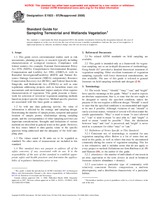We need your consent to use the individual data so that you can see information about your interests, among other things. Click "OK" to give your consent.
ASTM E1923-97(2008)
Standard Guide for Sampling Terrestrial and Wetlands Vegetation (Withdrawn 2013)
STANDARD published on 1.2.2008
The information about the standard:
Designation standards: ASTM E1923-97(2008)
Note: WITHDRAWN
Publication date standards: 1.2.2008
SKU: NS-43608
The number of pages: 19
Approximate weight : 57 g (0.13 lbs)
Country: American technical standard
Category: Technical standards ASTM
Annotation of standard text ASTM E1923-97(2008) :
Keywords:
mensuration, phytosociology, plant community sampling, vegetation, ICS Number Code 13.020.10 (Environmental management)
Additional information
| Significance and Use |
|
Vegetation sampling is useful for investigating plant succession and community composition for a variety of purposes including land use planning, resource surveys, assessment of vegetation response to toxic materials and other environmental stresses, and for ecological research (11). |
| 1. Scope |
|
1.1 This guide covers environmental studies such as risk assessments, planning projects, or research typically including characterization of ecological resources. Compliance with federal statutes (for example, National Environmental Policy Act 1970, (NEPA); Comprehensive Environmental Response, Compensation and Liability Act 1981, (CERCLA: with its Remedial Investigation/Feasibility (RI/FS) and Natural Resource Damage Assessment (NRDA) components); Resource Conservation Recovery Act (RCRA), and Federal Insecticide, Fungicide, and Rodenticide Act, (FIFRA)) as well as state regulations addressing projects such as hazardous waste site assessments and environmental impact analysis often requires characterization of vegetation. This guide presents a framework for selection of terrestrial vegetation sampling methods based on project-specific objectives. Method-specific practices are associated with this basic guide as annexes. 1.2 As with any data gathering activity, the value of information is affected by the strategy and sampling design. Determining the number of sample points, temporal and spatial location of sample points, relationships among sampling points, and the correspondence of other sampling activities are important considerations. Strengths and limitations of various methods are described in general terms in this guide. However, the key issues linked to data quality relate to the specific question being addressed and the adequacy of the field sampling plan. 1.3 &solely-SI-units; This standard does not purport to address all of the safety concerns, if any, associated with its use. It is the responsibility of the user of this standard to establish appropriate safety and health practices and determine the applicability of regulatory limitations prior to use. |
We recommend:
Technical standards updating
Do you want to make sure you use only the valid technical standards?
We can offer you a solution which will provide you a monthly overview concerning the updating of standards which you use.
Would you like to know more? Look at this page.




 Cookies
Cookies
